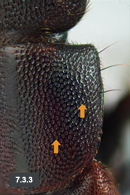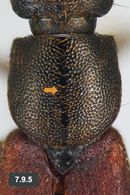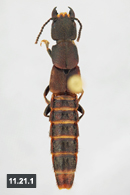
| Platydracus zonatus (Gravenhorst 1802) | |||||||||||||||||||||||||||||||||||
|
|||||||||||||||||||||||||||||||||||
Other material examined: 445 specimens throughout the range of the species, all being males with examined aedeagus. Full data will be presented in the pending revision of Platydracus by Newton, but all records that could be georeferenced are shown in Map 26. |
|||||||||||||||||||||||||||||||||||
| With the characters of the P. cinnamopterus Complex, plus: average pronotal length 2.31 mm (n = 9); head, pronotum and elytra usually medium to dark reddish, less often light red, pronotum more or less distinctly bicolored (darkest at anterior angles and sides and sometimes along median, rest of disc lighter); antenna reaching middle of pronotum when extended posteriorly, antennomere 9 slightly transverse; impunctate median line of pronotum at least one puncture diameter wide at narrowest point, usually about two puncture diameters wide; emargination of sixth visible male sternite in ventral view deep, about 1/3 as deep as wide; apex of median lobe of aedeagus projected in parameral view, the converging sides of the projection in ventral view usually slightly concave and forming an obtuse angle, the apex narrowly rounded; sides of median lobe in lateral view distinctly toothed near base of projection. | |||||||||||||||||||||||||||||||||||
Figure 7.3.2 Platydracus zonatus (Gravenhorst), apical antennomeres. 7.3.3 P. zonatus, lateral portion of pronotum.
|
|||||||||||||||||||||||||||||||||||
| Platydracus zonatus may be distinguished from all other species of the genus in ECAS by the combination of generally reddish color (medium to very dark) (Fig. 11.21.1) with a more or less distinctly bicolored pronotum (Fig. 7.3.3), black scutellum, and variegated abdomen with only sparse gold setae and paired areas of black velvet setae on the first five visible segments; antennae with slightly transverse antennomere 9 (Fig. 7.3.2) ; and the narrow but complete impunctate medial line of pronotum about 2 puncture diameters wide at narrowest (Fig. 7.9.5). It is definitively distinguished from the other members of the P. cinnamopterus Complex, P. cinnamopterus and P. praetermissus, by the structure of the aedeagus (Fig. 7.3.4, 11.21.3). | |||||||||||||||||||||||||||||||||||
Platydracus zonatus is widely distributed in the forested areas of eastern North America: from southern Québec, west to Kansas, south to Texas and east to peninsular Florida. Unlike P. cinnamopterus, its northern range is apparently constrained by the distribution of the Carolinian forest and is therefore regularly known in Canada only from a few sites in southern Ontario. Eastern Canada: ON, QC In ECAS, P. zonatus specimens have been collected from March through November, with a majority (56%) found in May or June. |
|||||||||||||||||||||||||||||||||||
 |
|
 |
|
 |
|||||||||||||||||||||||||||||||
A majority of specimens of P. zonatus from ECAS with microhabitat data have been collected in forests in various kinds of ground debris including forest leaf litter (Fig. 11.21.2) and under stones and logs; one specimen was found in Sphagnum moss, one at blacklight at night, several in prairie and old field areas, and several were collected in flight intercept traps. Unlike P. cinnamopterus, this species is not known to occur under bark. Note that some historical records of P. cinnamopterus in the literature may refer to this species. The partially illustrated larva of P. zonatus in Newton (1990) is based on a series of larvae collected with four confirmed adults of this species. |
|||||||||||||||||||||||||||||||||||









